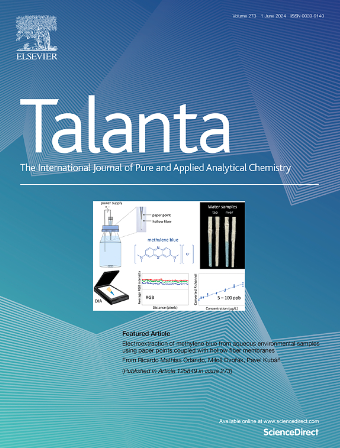A novel approach for profiling of nature-inspired and bioactive proteins and peptides isolated from selected medicinal plants and their implications in Alzheimer diseases by in-silico analysis
IF 5.6
1区 化学
Q1 CHEMISTRY, ANALYTICAL
引用次数: 0
Abstract
This study reported the profiling and the in-silico analysis of the therapeutic potential of proteins/peptides (for Alzheimer disease) isolated from Tinospora cordifolia, Evolvulus alsinoides, Centella asiatica and Convolvulus pluricaulis. The proteins/peptides were extracted by using four different pH based buffer solutions. The trypsin digested proteins/peptides were analyzed by LC-MS/MS based peptide mass fingerprinting which showed the presence of high number of proteins/peptides involved in regulating the oxidative stress. The sequential purification with 10 kDa and 3 kDa cut-off ultrafiltration membranes for buffer based extracted proteins/peptides was performed. The evaluation of crude and these filtrates revealed the highest antioxidant potential for 3 kDa cut-off filtrate of 0.1 M Tris HCl buffer (pH 8.0) from FRAP, DPPH, ABTS and NOS assays. The presence of peptides in 3 kDa cut-off filtrates was detected by HPLC, identified by MALDI-TOF MS and the fragmentation pattern was obtained by LC-MS/MS. The in-silico docking study revealed that the identified peptides showed the highest binding affinity against the Alzheimer targets (BACE1, nAChR, Aβ, AChE, GSK-3β, JNK). Thus, the findings of this study provided the preliminary evidence for the antioxidant and neuroprotective potential of the selected medicinal plants, by supporting their relevance in delaying the onset of neurodegeneration and highlighting their prospects for drug development.

从选定的药用植物中分离的受自然启发的生物活性蛋白和肽及其在阿尔茨海默病中的应用的一种新方法
本研究报道了从Tinospora cordifolia, Evolvulus alsinoides, Centella asiatica和Convolvulus pluricaulis中分离的蛋白/肽(阿尔茨海默病)的谱图和计算机分析。用四种不同pH的缓冲液提取蛋白质/肽。利用LC-MS/MS对胰蛋白酶消化的蛋白/多肽进行了分析,发现存在大量参与氧化应激调节的蛋白/多肽。用10 kDa和3 kDa切断超滤膜对提取的缓冲蛋白/肽进行顺序纯化。通过FRAP、DPPH、ABTS和NOS试验对原油和滤液进行评价,发现0.1 M Tris HCl缓冲液(pH 8.0)的3 kDa截止滤液具有最高的抗氧化潜力。HPLC检测3 kDa截留滤液中多肽的存在,MALDI-TOF MS鉴定,LC-MS/MS鉴定。硅对接研究显示,鉴定的肽对阿尔茨海默病靶点(BACE1, nAChR, Aβ, AChE, GSK-3β, JNK)具有最高的结合亲和力。因此,本研究结果为所选药用植物的抗氧化和神经保护潜力提供了初步证据,支持了它们在延缓神经退行性疾病发病方面的相关性,并强调了它们在药物开发中的前景。
本文章由计算机程序翻译,如有差异,请以英文原文为准。
求助全文
约1分钟内获得全文
求助全文
来源期刊

Talanta
化学-分析化学
CiteScore
12.30
自引率
4.90%
发文量
861
审稿时长
29 days
期刊介绍:
Talanta provides a forum for the publication of original research papers, short communications, and critical reviews in all branches of pure and applied analytical chemistry. Papers are evaluated based on established guidelines, including the fundamental nature of the study, scientific novelty, substantial improvement or advantage over existing technology or methods, and demonstrated analytical applicability. Original research papers on fundamental studies, and on novel sensor and instrumentation developments, are encouraged. Novel or improved applications in areas such as clinical and biological chemistry, environmental analysis, geochemistry, materials science and engineering, and analytical platforms for omics development are welcome.
Analytical performance of methods should be determined, including interference and matrix effects, and methods should be validated by comparison with a standard method, or analysis of a certified reference material. Simple spiking recoveries may not be sufficient. The developed method should especially comprise information on selectivity, sensitivity, detection limits, accuracy, and reliability. However, applying official validation or robustness studies to a routine method or technique does not necessarily constitute novelty. Proper statistical treatment of the data should be provided. Relevant literature should be cited, including related publications by the authors, and authors should discuss how their proposed methodology compares with previously reported methods.
 求助内容:
求助内容: 应助结果提醒方式:
应助结果提醒方式:


